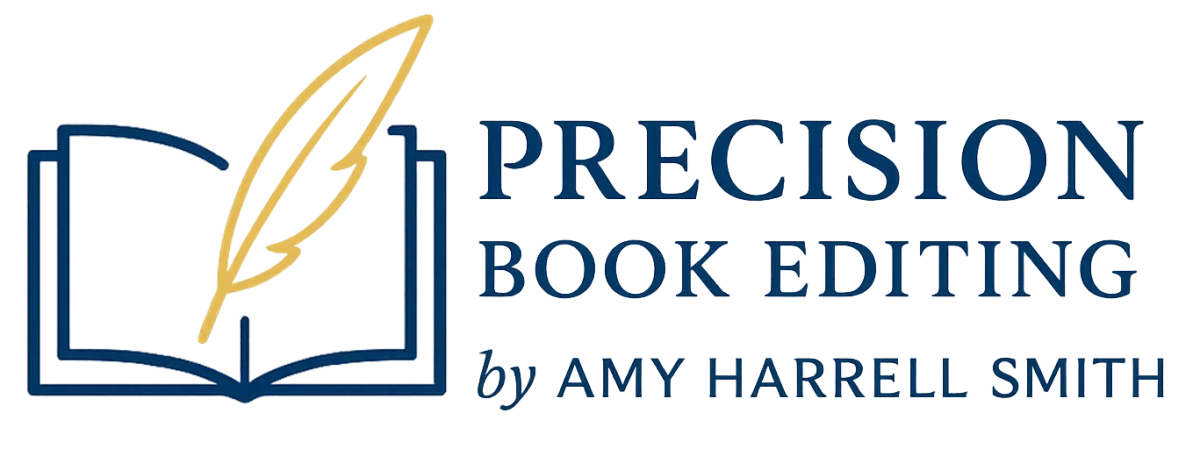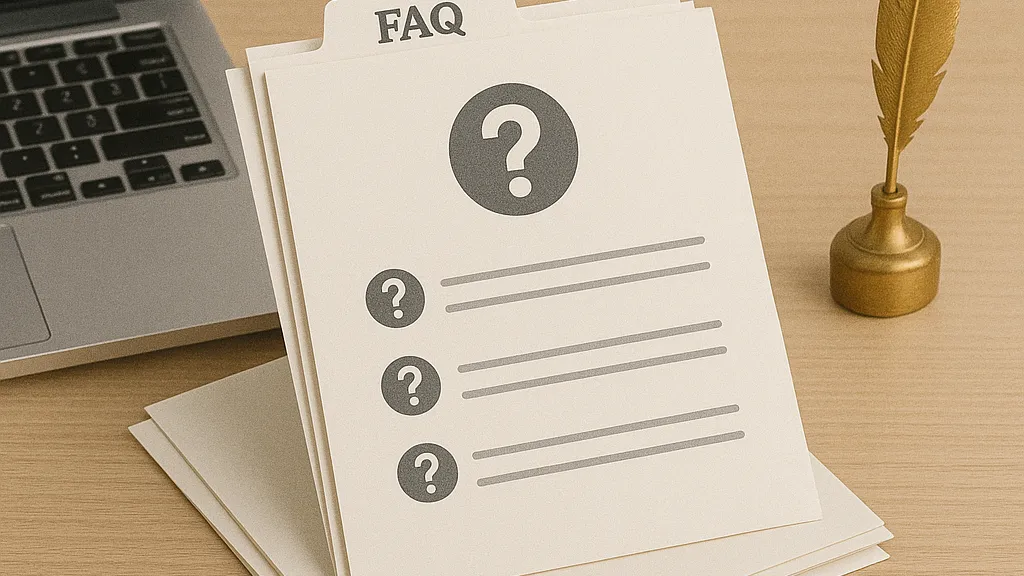
Self-publishing may seem complicated, but it doesn't have to be.
Let's break it down.
Frequently Asked Questions
About Manuscript Length & Page Count
How long should my manuscript be?
Manuscript length is highly subjective! Manuscripts are usually measured by word count more than pages, because (as we will see below) formatting greatly affects the page count.
My general recommendation is to use however many words it takes for you to express your message fully. This can vary greatly, depending on the complexity of your message or story, your intended audience, and your desired finished product.
For example, if you want to write a novel for women, your word count is going to be considerably higher than if you want to write a not-too-heavy but inspirational self-help book for young adults.
If you get to writing and find that your content is much more than you planned, but you still want to produce a shorter book, then you may consider breaking your content up into multiple books instead of cramming it all into one.
I can help you determine an appropriate approach to these kinds of issues in the developmental editing stage of working on your project.
How many pages will my book be?
Page count depends wildly on numerous formatting parameters. Let me show you some real-life examples from my own self-publishing experience in this graphic (click to enlarge).
As you can see, the first two books in the graphic both ended up being about 220 pages long... but they differed by 27,000 words!
The difference is explained by my desire for the second book, a daily devotional for parents, to be a smaller item they can easily hold in their hands and flip through from day to day. The desired output – a 5" x 8" book instead of my usual 6" x 9" output – was the primary reason the book yielded almost the same page count as my first book.
Formatting can work wonders in helping you accomplish the desired end result for your book's size and length.
For example, the client in the last line was concerned that the published product not feel like a booklet. We wanted the book to be at least thick enough to have a spine that text could be printed on. The message was complete in just 22,000 words, so there was no need to expound on it or add "fluff" just to try to reach a certain page count. I adjusted various formatting parameters (including adding quote blurbs, available in my Specialty Add-Ons services) to ensure that the message came across as a substantial enough book so that readers would give it the serious attention it deserved.
In the full-service formatting phase of your project, we will discuss your ideal final product, and I will advise you on options we can use to achieve that end result.
Click image to enlarge.

What do Levels 1-4 mean on this page?
Because longer manuscripts require longer time to edit and format, I price many of my services according to the estimated length of your completed manuscript. To make pricing easier, I have divided manuscript length into levels:
Level 1: 0 - 50,000 words
Level 2: 50,001 - 75,000 words
Level 3: 75,001 - 100,000 words
Level 4: 100,001 - 125,000 words
Close to a Level Break?
If your manuscript is just slightly over a word count limit, reach out! I'm happy to offer a prorated adjustment so you're not paying for a full level jump. Go ahead and place your order at the lower level to secure your spot on my schedule — I’ll follow up with the adjustment amount before we move forward.
Click image to enlarge.
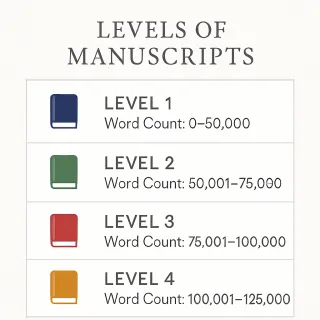
About Our Services
What is developmental editing?
Developmental editing is help with the "big picture" or high-level organization of your manuscript. Think of it as designing the architecture of the house and building the walls. It's establishing the framework, making sure there are doorways where needed, and providing a good flow through the house.
In a fiction work, this would look at the overall story structure, character development, and pace of the plot's unfolding. In a nonfiction work, it would seek to arrange concepts to go together more naturally, reduce redundancy, and identify portions that warrant more detail and development.
When working on a lengthy manuscript over the course of weeks, months, or years, it is very easy to forget that you have already covered a certain point and to create redundancies in your message (I've caught myself doing this many, many times). Developmental editing will help you identify these areas and consolidate redundancies so that you can simply reference back to the point you've already made as needed.
Example: In a nonfiction work I was editing, I noticed that the author kept revisiting a particular topic over and over, sometimes repeating what had already been well-addressed. As the reader, I felt jerked back and forth when I thought we had settled and moved on from that topic. In this case, I took a deep-dive into the overall structure of the book's message, developed a way to combine the various segments into one, and proposed the new flow to the author. The author agreed that the high-level rearrangement would help the reader stay engaged in a natural flow of thought, so we then implemented my proposal into the final manuscript.
On the flip side, as an author who knows what you mean to say, it's easy to take for granted that the audience will understand your intended meaning. That's not always the case. Developmental editing is useful for helping you identify on a high level which concepts feel rushed over and unclear, so that you can take the time to flesh out those concepts in greater detail. (Content editing also helps with this clarity on a lower level, working within sentences and paragraphs as opposed to large sections and chapters).
What is content editing?
On the surface, content editing may sound like developmental editing, but it's different in terms of what it tackles.
If developmental editing is the overall framework of the house, think of content editing as the interior design. Now we're picking out paint colors, making sure nothing clashes, and creating a welcoming environment.
Content editing, which in my services also includes line editing, is the part of the process when we work through your manuscript paragraph by paragraph and sentence by sentence, making sure your desired meaning is coming across.
Again, because authors know what we mean to say, we often assume the reader will read it the way we intended. That's not always true.
For example, when reviewing an essay recently, I ran across a sentence about two parties' points of view in early America:
"Both parties were concerned that the new laws did not cater to the opposing party's stance."
I suspected I knew what the writer meant to say, but the actual sentence was saying the opposite of what the author intended. The author meant to convey that both parties wanted to ensure that the new laws did not cater to the opposing party; in this case, they were protecting their own interests. However, the way the sentence is structured, the author is stating that the parties are concerned because the new laws weren't catering to the opposite party; in this case, they were protecting the opposing party's interests.
When I work with an author on content editing, I seek to identify any areas where the intended meaning could be misconstrued, and we work together to rectify that.
Beyond that, I help the author improve sentences to help the reader follow along. Just because a very long sentence is grammatically correct does not mean a reader will stay with you until the end!
Content editing is largely about style and tone, and I also go ahead in this phase and begin correcting mechanics (grammar, spelling, capitalization, and punctuation), which will help the proofreading phase go much more smoothly.
What is the difference between developmental and content editing?
Think of developmental editing as working with the framework of the house: tweaking the architect's plans, solidifying the foundation, and putting the walls up and the roof on. We're making sure the rooms flow together in a logical order and in such a way that the guests entering feel at home right away. Literally, this deals with the overall organization, structure, and flow of your manuscript. (See section about developmental editing for more details).
Think of content editing as interior design and adjustments: changing paint colors to invoke the desired feel, rearranging pieces of furniture to make a room more functional and inviting, or adding little touches of decor to enhance the feel of the space. Literally, this deals with paragraph and sentence structure, tone, and clarity. Here at Precision Book Editing, content editing and line editing are included together as one service.
Click image to enlarge.

What does proofreading include?
Traditionally, proofreading is the final read-through to verify the absence of errors in grammar, spelling, capitalization, and punctuation.
Copy editing is typically the process prior to this final read-through, in which errors are identified and corrected.
Here at Precision Book Editing, copy editing is included with the proofreading service. With this one service, I will review your manuscript, identify and correct (or suggest corrections for) all errors, and proofread the final draft to ensure correctness.
Proofreading does not include revising for style or clarity, restructuring, or reorganizing (see "content editing" for this level of revisions).
Do you offer line editing or copy editing?
Yes! While there are various categories of editing, they can frequently overlap one another. To simplify things, here at Precision Book Editing:
✅ Line editing is included in the content editing service.
✅ Copy editing (checking for grammar, punctuation, spelling, and capitalization) is included in the proofreading service.
What does your full-service formatting (for print) include?
Precision Book Editing's Full-Service Formatting is designed to take your manuscript from a diamond in the rough to a polished gem ready for publishing.
This service includes formatting all aspects of your book's interior (black and white, text-only, unless Specialty Add-Ons have been purchased or a custom quote has been agreed upon to include graphics/photo placement).
This includes:
✅ Setting up the final document size, including page size, margins, and gutters, according to your printer's/publisher's specifications.
✅ Establishing typography--fonts, sizes, paragraph spacing, and justification--for various levels of text in your book (chapter titles, subheadings, paragraph text, etc.).
✅ Applying appropriate typography throughout.
✅ Adding page numbers throughout and ensuring proper placement (alternating left/right or centered, suppressed where needed, etc.).
✅ Adding page headers throughout (alternating book title/author name and chapter titles, as desired by author or as indicated by industry standards).
✅ Adding a Table of Contents (if desired).
✅ Placing front matter and back matter appropriately for the project (This might include the title page, copyright page,* Dedication, "About the Author" page, "More works by this author," or website or social media information).
Does not include:
The creation of an index; please see Specialty Add-Ons for this option.
*The creation of a copyright page, which is offered as a separate service if purchasing a la carte or Build-Your-Own. However, it is included in all three packages.
What is the creation of a copyright page, and why would I need one?
Every published book needs a copyright page. If for no other reason than to establish that you hold the copyright and to provide the relevant publication information, a copyright page is an essential component in the front matter of your book.
Furthermore, if you did not create the book's cover design entirely on your own, or if you have directly quoted Scripture from the Holy Bible in your book, then the copyright page is a valuable place to give proper credit where credit is due.
Reference the screenshot here of the copyright page for my novel, Maddie, Beloved. Because I directly quoted Scripture in the text, I needed to attribute credit as required by the versions I quoted. Because I wrote a fictional story, I decided to include the disclaimer about there being no intentional connection to real people. Because my son contributed to the artwork for the cover, I give him credit here for his drawing (even though I hold the copyright for the cover design). Finally, I provide the year of the book's creation (completion), I confirm that the copyright is held in my name, and I provide the standard publishing/ISBN information.
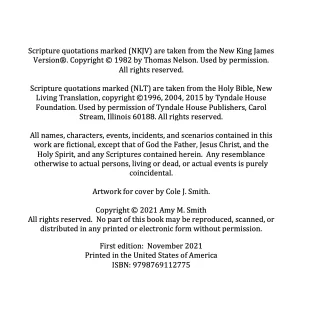
What is the expanded copyright page that uses Scripture credits, and why would I need one?
For Christian books that quote from the Bible, it is customary to designate on the copyright page which versions are used, which abbreviations indicate each version, and which authorization you are using the quotes under.
But isn't it free to quote the Bible?
Yes but no.
Yes, it is "free" in that you likely will not have to pay for a license to quote from the Bible.
No, it is not "free" in that you cannot simply quote to your heart's content without limitations or attribution (Keep reading).
Bible versions are published, copyrighted works. It may come as a surprise to you, but with very few exceptions (like the King James Version, which is now in the public domain), most versions of the Bible are protected by copyrights held by the publishers of those versions. However, most of these publishers have generous public use policies that allow verbatim quotes of their versions to be used in published works as long as you meet their criteria.
Attribution: There is almost always a stipulation that you provide credit per their specifically required verbiage on your copyright page. Additionally, there is almost always the requirement that you designate quoted verses from their version with a specific abbreviation (e.g., NKJV, NIV, NLT)--unless you have issued a blanket statement that all unmarked verses are from their version.
Limits: Some versions limit the amount of total verses from their version that you may quote in your work, and/or they limit the overall percentage of your work that can be comprised of quoted verses. In other words, you can't just copy/paste massive passages from their version into your book and add a few token commentaries to it. Their quoted text cannot be the bulk of your work.
Most authors will not come close to infringing on these boundaries, as long as they follow the attribution requirements. However, I encourage authors from the onset of writing your manuscript (1) to begin tracking which versions you are using and (2) to label each verse with the version it is from as you insert it in the manuscript. Trust me: It is much easier to compile this information from the beginning and as you go than it is to have to backtrack and try to look up versions after-the-fact!
Is this overwhelming? Don't worry. With my expanded copyright page service, which is included in all three packages and can also be purchased as an a la carte service, I take care of this for you! You tell me which versions you used and identify the versions for each verse; I research the attribution requirements from the publisher and insert it onto your copyright page for you.
What does the citation service include?
Many authors want to write a great book, but they either forget or don't know that they're supposed to give proper credit to anyone they quote within their work.
My citation assistance services include:
✅ Working closely with the author to properly document all references used in your work. I will help identify where references are needed; the author will be responsible for providing me the necessary information for each source.
✅ Working with the author to select the appropriate method of citing these sources (e.g., footnotes at the bottom of the page or endnotes at the end of the chapter or at the very end of the book).
✅ Inserting footnotes and endnotes throughout your work, citing each source appropriately to ensure proper credit is given.
What does copyright registration assistance include?
Your original book is a creation that you have put careful thought, labor, and intention into. You will likely want to protect your work by registering the copyright with the U.S. Copyright Office (Library of Congress).
Having copyrighted numerous original songs and books, I am very familiar with the process and nuances of filing a copyright registration.
My copyright registration assistance helps you by either walking you through the process so you can learn to do each step yourself or by doing the entire process for you--It's your preference. The steps include:
✅ Creating your account with the U.S. Copyright Office (if you do not already have one).
✅ Completing the online application to register a new work.
✅ Submitting payment of the registration fee (not included in the fee you pay Precision Book Editing).
✅ Submitting files of your book with your application.
✅ If necessary, I will respond to any follow-up inquiries the Copyright Office sends in relation to your filing.
Within several weeks of filing your registration, you will receive a certificate from the U.S. Copyright Office confirming your copyright registration.
What does Amazon KDP Setup do for me?
Amazon KDP Setup for Print includes:
✅ Assisting you with the creation and setup of your Amazon KDP author account (if you do not already have one).
✅ Assisting with setting up your book listing inside of Amazon KDP and selecting proper parameters to prepare your book for paperback or hardcover publication.
✅ Assisting with selecting options for pricing and publishing on Amazon.
✅ Uploading final files to the Amazon KDP portal.
✅ Reviewing the digital proof inside of Amazon.
✅ Ordering a physical proof (if desired; this is an additional but nominal cost payable to Amazon for printing and shipping your proof).
✅ Submitting for publication.
Amazon KDP Setup for eBook includes:
✅ Assisting you with the creation and setup of your Amazon KDP author account (if you do not already have one).
✅ Assisting with setting up your book listing inside Amazon KDP to prepare for eBook publication.
✅ Assisting you with selecting options for pricing and publishing on Amazon.
✅ Uploading the eBook file to the Amazon KDP portal.
✅ Reviewing the digital proof inside Amazon.
✅ Submitting for publication.
Note: This service does not include the creation of your eBook file. This is a separate service available our a la carte menu; however, it is included in our Amazon KDP bundle as well as in the Platinum Package.
What does "Basic Cover Design" mean?
While I do not claim to be a professional graphic designer, I am able to provide basic cover design options for authors who find this a suitable option.
I have designed the covers for my books, Maddie, Beloved, and Equipped to Educate. I typically use simplified color palettes, stock photos for which I have the license or artwork to which I hold the copyright, and straightforward design.
My Platinum Package includes a basic cover design for your book.
Who is this for? Authors who are not very picky, who do not want to hire a designer, and/or who are working on a tight budget or tight deadline might find this a suitable option.
Who is this not for? Authors who are particular about graphic design or tend to ask for multiple revisions or adjustments to a design.
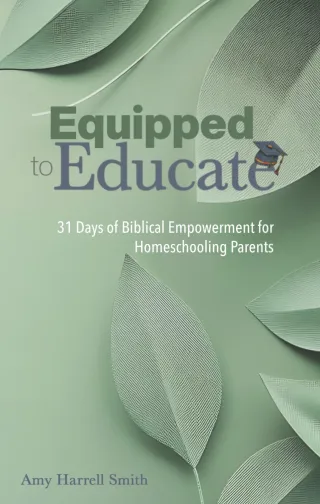
About Timelines & Ordering
How far in advance should I book my editing project?
I recommend booking 1–2 weeks in advance to secure your spot on my calendar. This allows time for onboarding, contract finalization, and any prep work before editing begins.
How long will the full editing process take?
For the Platinum Package on a Level 1 manuscript (up to 50,000 words), full-service editing at a normal pace takes approximately 6–8 weeks. This includes developmental editing, content editing, proofreading, and formatting. Longer or more complex manuscripts may take 8–14 weeks, and premium/specialty add-ons may extend the time further.
Of course, timing is also contingent on prompt responses from you throughout the process. If you are quick to respond to requests for information and revisions, it will help move the process along faster.
Rush timeframes are often available; if you are on a strict deadline, please don't hesitate to reach out & inquire about the feasibility of your project.
Can you work on a faster timeline if I’m on a deadline?
Oftentimes, yes. Shorter timelines can be accommodated depending on availability and manuscript complexity. Rush fees may apply.
When does the timeline start?
Your project officially begins after the deposit is received, the contract is signed, and all materials are submitted to me. I’ll provide a clear timeline when your booking is confirmed.
What if I need extra time to return my revisions?
That's completely fine. I understand that life happens and revisions can take time. I'm happy to pause the timeline while you're working through changes. Just keep in mind that extended delays on your end may affect my availability to resume your project right away. Nevertheless, I value flexibility, and we can work together to adjust the timeline as needed.
When are fees paid?
For all non-editing or non-formatting services (e.g., Amazon KDP Setup, Copyright Registration Assistance), 100% is due at the time of ordering.
For all editing & formatting services, including all packages:
You have two options:
1. You can pay entirely upfront.
2. You can pay 50% when you order and 50% toward the completion of your project, per the terms of your contract.
Please note: Final files will not be released to you, nor will they be uploaded to Amazon KDP or to the U.S. Copyright Office, until full payment has been received.
What does the ordering & onboarding process look like?
Great question!
Every project must be reviewed and accepted before work begins. The steps to make this happen are:
Place your order online, confirming that your manuscript does not violate our content guidelines, and pay the 50% upfront cost of your order.
Within 2 business days, you should hear from me about scheduling our initial discussion and/or you should receive your customized Master Service Agreement from me.
At the point of signing your agreement, you will need to submit your manuscript to me for review.
Once I have your signed agreement, have confirmed acceptance of your project, and have received your 50% payment, we'll get to work!
About Working with a Christian Editor
Why does it matter to have a Christian editor?
Your book is so much more than just words and mechanics. That's why you need an editor who is so much more than just a grammar enthusiast or a solid proofreader.
For Christian authors, having a biblically grounded, faith-focused, Christian editor is a game changer. A seasoned Bible student/teacher can enhance your Christian manuscript in several ways:
✅ I can quickly identify where you may need or want to insert references to Bible verses throughout your work (included in my Citation Assistance service). For example, your manuscript might say, "You can be assured that God will provide all your needs!" In my review, I would suggest a reference to Philippians 4:19; if you agree, we would determine whether that should be a parenthetical reference, a footnote, or an endnote. If your file says, "You have the power to control your thoughts through the Word of God," I would suggest a reference to Philippians 4:8, 2 Corinthians 10:5, and/or Romans 12:2.
✅ I can help you connect scriptural concepts from one section of your manuscript to another, helping enhance the flow of thought for your reader (included in my Developmental Editing service and on a smaller scale in my Content Editing service).
✅ I can catch unintentional errors in misquoting Scripture. Even the best of us sometimes get verses mixed up, or as we're typing, we accidentally leave out some words. A Christian editor is more likely to pick up on any omissions or typos in cases like this.
✅ I can suggest additional ways to drive home a point biblically, oftentimes offering additional Scripture to reinforce your message. For example, when working with one minister's newsletter, I recognized that his point easily dovetailed into another concept I had recently heard about in a sermon at church. I was able to suggest the integration of the new material, which he gladly accepted to enhance his message to his readers. (And don't worry; if I ever suggest material from someone else's work, I will make sure you have the proper information to give credit appropriately.)
It is invaluable to have an editor who is familiar with your faith, doctrines, and values to serve on your project with you. Working together is like iron sharpening iron, molding your manuscript to have the greatest possible impact when you release it to your audience!
Do you accept both Christian nonfiction and fiction?
Enthusiastically, yes!!
I have personally authored and self-published both kinds of books, and I welcome the opportunity to work on either type of manuscript. Whether you're writing a Christian ministry/lifestyle book or a Christian romance novel or thriller, I'm open to serving on your project in whatever way I can.
Do you only work on Christian projects?
Not exclusively. While I specialize in working with Christian authors, I’m happy to consider other projects as long as the content aligns with my values. That means no profanity, vulgarity, or morally objectionable material.
Please note: While I aim to serve as many authors as I can, I reserve the right to respectfully decline any manuscript if it’s not a good fit for my services or values.
© Becoming Wiser, LLC 2025
